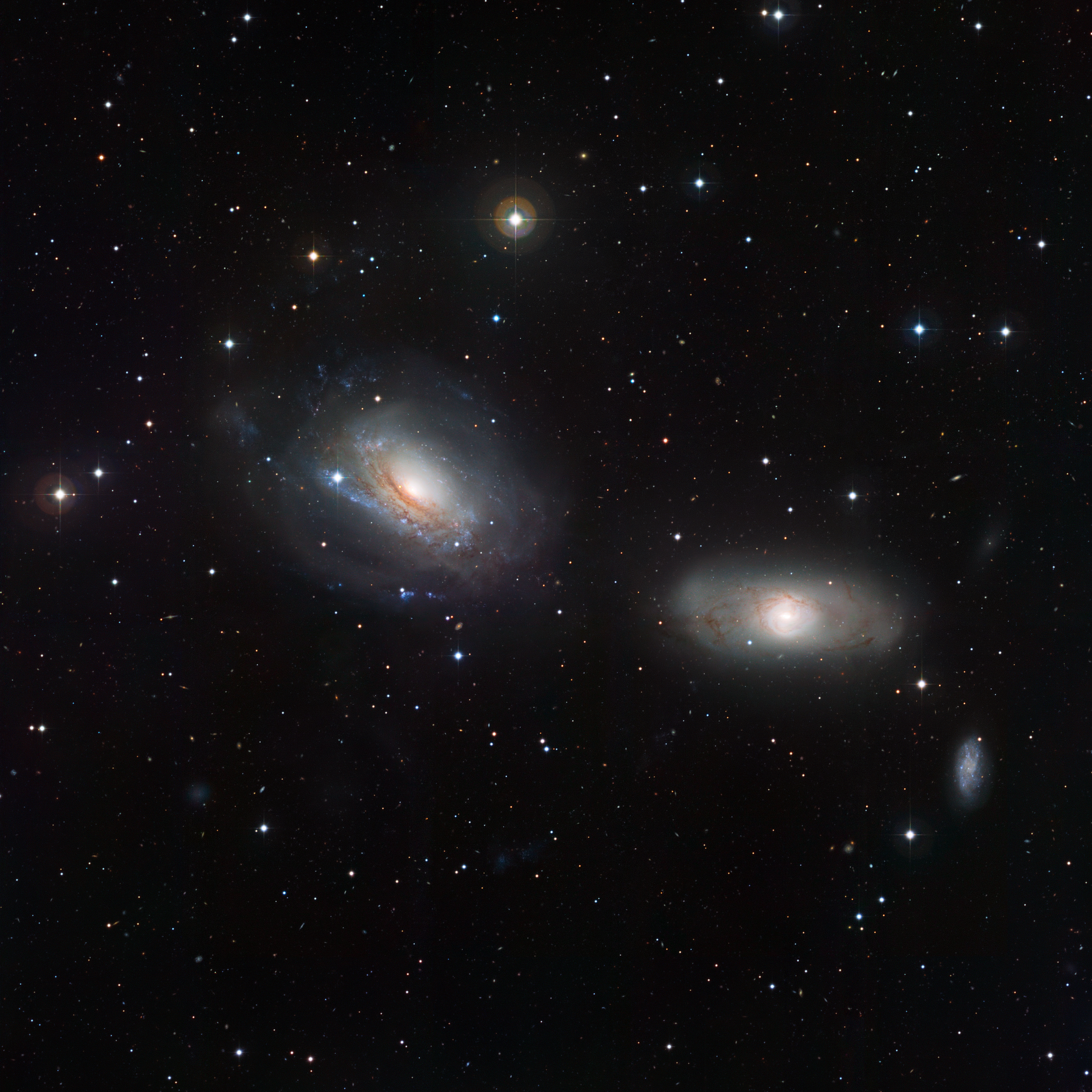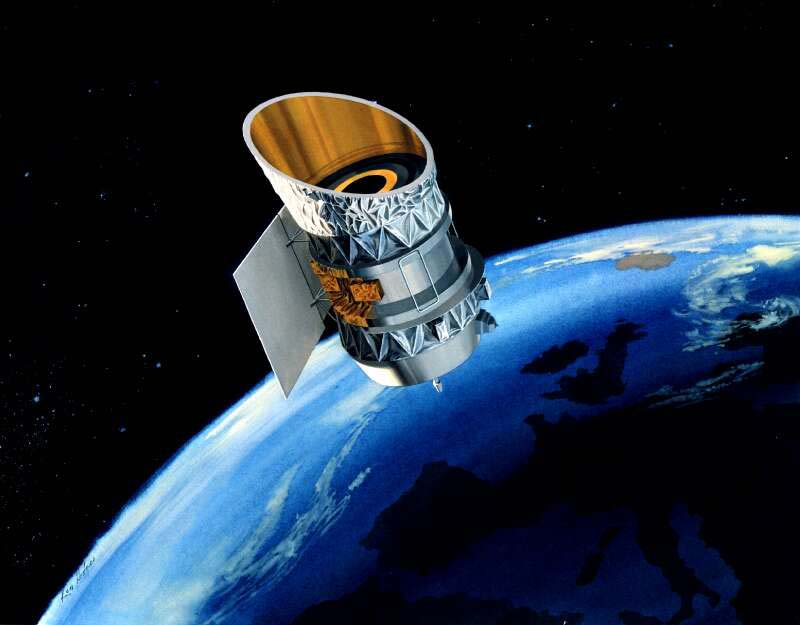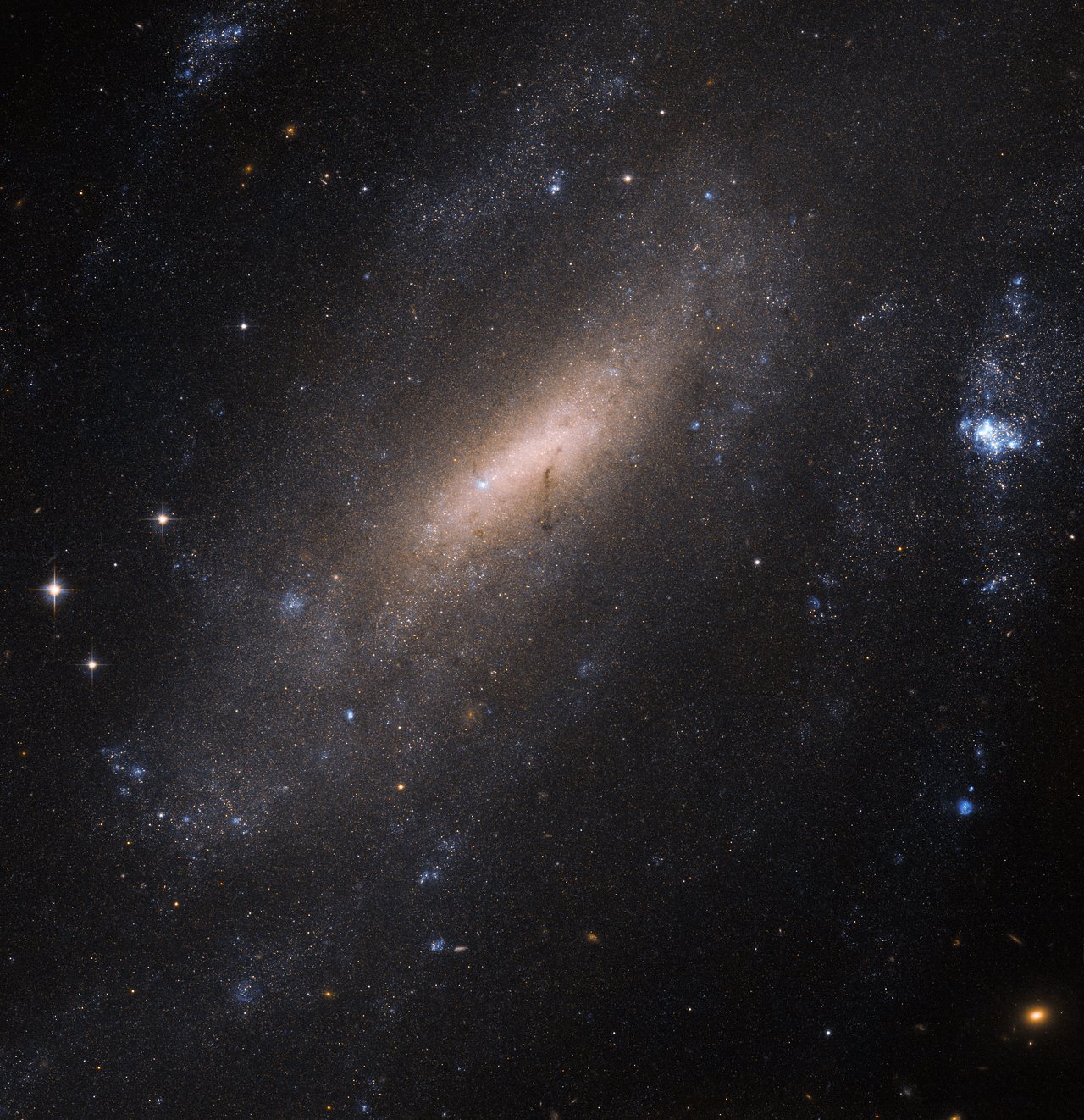|
UGC 2885
UGC 2885 ( Rubin's Galaxy, nicknamed "Godzilla galaxy") is a large barred spiral galaxy of type ''SA(rs)c'' in the constellation Perseus. It is from Earth and measures across, making it one of the largest known spiral galaxies. It is also a possible member of the Pisces-Perseus supercluster. UGC 2885 is a spiral galaxy with a relatively low surface brightness. The central bulge is the most prominent feature of this galaxy, where a faint bar crosses its center. UGC 2885 is classified as a field galaxy—a class of galaxies found in remote, under-dense and “vacant” sections of space, far from other major galaxies. NASA has reported that the theorized main source for disk growth for UGC 2885 came from the accretion of intergalactic hydrogen gas, rather than through the repeated process of galactic collision, as most galaxies are thought to grow. The lack of interaction is evident from the near-perfect structure of the spiral arms and disk, lack of tidal tails, and ... [...More Info...] [...Related Items...] OR: [Wikipedia] [Google] [Baidu] |
Uppsala General Catalogue
The Uppsala General Catalogue of Galaxies (UGC) is a catalogue of 12,921 galaxies visible from the northern hemisphere. It was first published in 1973. The catalogue includes essentially all galaxies north of declination -02°30' and to a limiting diameter of 1.0 arcminute or to a limiting apparent magnitude of 14.5. The primary source of data is the blue prints of the Palomar Observatory Sky Survey (POSS). It also includes galaxies smaller than 1.0 arcminute in diameter but brighter than 14.5 magnitude from the Catalogue of Galaxies and of Clusters of Galaxies (CGCG). The catalogue contains descriptions of the galaxies and their surrounding areas, plus conventional system classifications and position angles for flattened galaxies. Galaxy diameters are included and the classifications and descriptions are given in such a way as to provide as accurate an account as possible of the appearance of the galaxies on the prints. The accuracy of coordinates is only what is necessary for ... [...More Info...] [...Related Items...] OR: [Wikipedia] [Google] [Baidu] |
Galactic Collision
Interacting galaxies (''colliding galaxies'') are galaxies whose gravitational fields result in a disturbance of one another. An example of a minor interaction is a satellite galaxy disturbing the primary galaxy's spiral arms. An example of a major interaction is a galactic collision, which may lead to a galaxy merger. Satellite interaction A giant galaxy interacting with its satellites is common. A satellite's gravity could attract one of the primary's spiral arms. Alternatively, the secondary satellite can dive into the primary galaxy, as in the Sagittarius Dwarf Elliptical Galaxy diving into the Milky Way. That can possibly trigger a small amount of star formation. Such orphaned clusters of stars were sometimes referred to as "blue blobs" before they were recognized as stars. Galaxy collision Colliding galaxies are common during galaxy evolution. The extremely tenuous distribution of matter in galaxies means these are not collisions in the traditional sense of the word, ... [...More Info...] [...Related Items...] OR: [Wikipedia] [Google] [Baidu] |
IRAS Catalogue Objects
The Infrared Astronomical Satellite ( Dutch: ''Infrarood Astronomische Satelliet'') (IRAS) was the first space telescope to perform a survey of the entire night sky at infrared wavelengths. Launched on 25 January 1983, its mission lasted ten months. The telescope was a joint project of the United States ( NASA), the Netherlands ( NIVR), and the United Kingdom ( SERC). Over 250,000 infrared sources were observed at 12, 25, 60, and 100 micrometer wavelengths. Support for the processing and analysis of data from IRAS was contributed from the Infrared Processing and Analysis Center at the California Institute of Technology. Currently, the Infrared Science Archive at IPAC holds the IRAS archive. The success of IRAS led to interest in the 1985 Infrared Telescope (IRT) mission on the Space Shuttle, and the planned Shuttle Infrared Telescope Facility which eventually transformed into the Space Infrared Telescope Facility, SIRTF, which in turn was developed into the Spitzer ... [...More Info...] [...Related Items...] OR: [Wikipedia] [Google] [Baidu] |
MCG Objects
The Melbourne Cricket Ground (MCG), also known locally as "The 'G", is an Australian sports stadium located in Yarra Park, Melbourne, Victoria. Founded and managed by the Melbourne Cricket Club, it is the largest stadium in the Southern Hemisphere, the 11th largest globally, and the second largest cricket ground by capacity. The MCG is within walking distance of the city centre and is served by Richmond and Jolimont railway stations, as well as the route 70, route 75, and route 48 trams. It is adjacent to Melbourne Park and is part of the Melbourne Sports and Entertainment Precinct. Since it was built in 1853, the MCG has undergone numerous renovations. It served as the centerpiece stadium of the 1956 Summer Olympics, the 2006 Commonwealth Games and two Cricket World Cups: 1992 and 2015. It will also serve as the host for the opening ceremonies of the 2026 Commonwealth Games. Noted for its role in the development of international cricket, the MCG hosted both the fir ... [...More Info...] [...Related Items...] OR: [Wikipedia] [Google] [Baidu] |
UGC Objects
UGC may refer to: Science and technology * Universal gravitational constant G, in physics * Uppsala General Catalogue, an astronomical catalogue of galaxies * UGC, a codon for cysteine * Unique games conjecture, a conjecture in computational complexity Organisations * UGC (cinema operator), a European cinema chain, formerly Union Générale Cinématographique * UGC Fox Distribution, a former French-American film production company formed in 1995 * Union Graduate College, Schenectady, New York * United Grain Company, a Russian grain trading company based in Moscow * University Grants Commission (other) * University Grants Committee (other) * UnitedGlobalCom, former name of the cable TV operator Liberty Global * UnderGround Crips, an African American street gang mainly from Los Angeles, California Other * User-generated content, media content made by the general public * Urine Good Company, a fictional corporation in the musical ''Urinetown ''Urinetown: The Musi ... [...More Info...] [...Related Items...] OR: [Wikipedia] [Google] [Baidu] |
Unbarred Spiral Galaxies
A barred spiral galaxy is a spiral galaxy with a central bar-shaped structure composed of stars. Bars are found in about two thirds of all spiral galaxies, and generally affect both the motions of stars and interstellar gas within spiral galaxies and can affect spiral arms as well. The Milky Way Galaxy, where the Solar System is located, is classified as a barred spiral galaxy. Edwin Hubble classified spiral galaxies of this type as "SB" (spiral, barred) in his Hubble sequence and arranged them into sub-categories based on how open the arms of the spiral are. SBa types feature tightly bound arms, while SBc types are at the other extreme and have loosely bound arms. SBb-type galaxies lie in between the two. SB0 is a barred lenticular galaxy. A new type, SBm, was subsequently created to describe somewhat irregular barred spirals, such as the Magellanic Clouds, which were once classified as irregular galaxies, but have since been found to contain barred spiral structures. Among o ... [...More Info...] [...Related Items...] OR: [Wikipedia] [Google] [Baidu] |
SIMBAD
SIMBAD (the Set of Identifications, Measurements and Bibliography for Astronomical Data) is an astronomical database of objects beyond the Solar System. It is maintained by the Centre de données astronomiques de Strasbourg (CDS), France. SIMBAD was created by merging the Catalog of Stellar Identifications (CSI) and the Bibliographic Star Index as they existed at the Meudon Computer Centre until 1979, and then expanded by additional source data from other catalogues and the academic literature. The first on-line interactive version, known as Version 2, was made available in 1981. Version 3, developed in the C language and running on UNIX stations at the Volgograd Observatory, was released in 1990. Fall of 2006 saw the release of Version 4 of the database, now stored in PostgreSQL, and the supporting software, now written entirely in Java. JP11 is a star catalogue containing about 4,000 objects. Currently it exists only as a part of the SIMBAD database. , SIMBAD contains infor ... [...More Info...] [...Related Items...] OR: [Wikipedia] [Google] [Baidu] |
NGC 262
NGC commonly refers to: * New General Catalogue of Nebulae and Clusters of Stars, a catalogue of deep sky objects in astronomy NGC may also refer to: Companies * NGC Corporation, name of US electric company Dynegy, Inc. from 1995 to 1998 * National Gas Company of Trinidad and Tobago, state-owned natural gas company in Trinidad and Tobago * National Grid plc, a former name of National Grid Electricity Transmission plc, the operator of the British electricity transmission system * Northrop Grumman Corporation, aerospace and defense conglomerate formed from the merger of Northrop Corporation and Grumman Corporation in 1994 * Numismatic Guaranty Corporation, coin certification company in the United States Other uses * National Gallery of Canada, art gallery founded in 1880 in Ottawa, Canada * National Geographic, documentary and reality television channel established in the United States in 2001 formerly called National Geographic Channel * Native Girls Code, US non-profit orga ... [...More Info...] [...Related Items...] OR: [Wikipedia] [Google] [Baidu] |
Malin 1
__NOTOC__ Malin 1 is a giant low surface brightness (LSB) spiral galaxy. It is located away in the constellation Coma Berenices, near the North Galactic Pole. , it is the largest known spiral galaxy, with an approximate diameter of , thus over six times the diameter of our Milky Way. It was discovered by astronomer David Malin in 1986 and is the first LSB galaxy verified to exist. Its high surface brightness central spiral is across, with a bulge of . The central spiral is a SB0a type barred-spiral. Malin 1 is peculiar in several ways: its diameter alone would make it the largest barred spiral galaxy ever to have been observed. Malin 1 was found later to be interacting with two other galaxies, Malin 1B and SDSS J123708.91+142253.2. Malin 1B is located away from the high surface brightness central spiral of Malin 1, which may be responsible for the formation of the galaxy's central bar. Meanwhile, SDSS J123708.91+142253.2 is located within the huge, faint halo of Malin 1 and ... [...More Info...] [...Related Items...] OR: [Wikipedia] [Google] [Baidu] |
NGC 6872 And IC 4970
NGC 6872, also known as the Condor Galaxy, is a large barred spiral galaxy of type ' in the constellation Pavo. It is from Earth and is approximately five billion years old. is interacting with the lenticular galaxy , which is less than one twelfth as large. The galaxy has two elongated arms with a stellar diameter of over , and a D25.5 isophotal diameter of over , making it the largest known spiral galaxy. It was discovered on 27 June 1835 by English astronomer John Herschel. Star formation rates When observed in the ultraviolet and mid-infrared, the central region and bar of show old stars and low rates of star formation, with rates increasing along the spiral arms as distance from the core increases. The most active region of star formation, located in the northeast arm, shows a stellar flux around 1,000 times higher than in the central region, though this may be affected by the density of stellar dust in the core. The extended portions of both arms exhibit young star ... [...More Info...] [...Related Items...] OR: [Wikipedia] [Google] [Baidu] |
IC 1101
IC 1101 is a class S0 supergiant ( cD) lenticular galaxy at the center of the Abell 2029 galaxy cluster. It has an isophotal diameter at about . It possesses a diffuse core which is the largest known core of any galaxy to date, and also hosts a supermassive black hole that is one of the largest black holes known. The galaxy is located at from Earth. The galaxy was discovered on 19 June 1790, by the British astronomer William Herschel. Characteristics Morphology The galaxy is classified as a supergiant elliptical (E) to lenticular (S0) and is the brightest galaxy in A2029 (hence its other designation A2029-BCG; BCG meaning '' brightest cluster galaxy''). The galaxy's morphological type is debated due to it possibly being shaped like a flat disc but only visible from Earth at its broadest dimensions. A morphology of S0- (Hubble stage -2; see Hubble stage for details) has been given by the Third Reference Catalogue of Bright Galaxies (RC3) in 1991. Size IC 1101 is considered ... [...More Info...] [...Related Items...] OR: [Wikipedia] [Google] [Baidu] |





